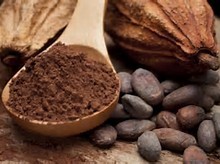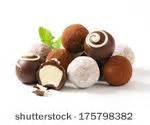National Chocolate Day

source: gbgindonesia.com
On the food calendar, there are days for celebrating chocolate in various forms: dark (February 1; the whole month is devoted to chocolate and has multiple observance days), cake (January 27), candy (December 28), to name a few.
This Friday, October 28, is a general yay-for-chocolate day. In recent years, cocoa has been returned to its roots as a nourishing, enriching food. Increasingly, clinical studies show it’s benefits in reducing blood pressure, preventing heart disease and cancer and enhancing mood. Thanks to the wonders of so many wonderful imaginations, we can have our cake/cookies/brownies/smoothies and cheerfully consume them too. And it makes a simple but effective face powder.
Will cocoa grow in the Mid-Atlantic? As it turns out, yes it can. But.
Theobroma cacao is a highly sensitive plant that demands a great deal of attention if it is to yield its fruit. In its natural environment, it grows in the shade of taller trees, in a humid climate that is within a narrow range of temperatures. To bring those growing conditions here to the East Coast, an enterprising grower would have to come indoors to a controlled environment. While the summer humidity of our region would make TC deliriously happy, the hot and highly changeable temperatures would make it wither and die.
TC will grow in dim lighting, take daily misting in a room set at a consistent temperature between 60 and 79 degrees (F) and a humidity level of about 70 percent. It matters where the leaves are misted; in its early stages, misting the top side of the leaves would weigh them down so spritz spritz on the underside only. TC must be fed regularly during its growing phase.
Seeds and seedlings can be obtained from local or online nurseries or garden centers. If purchasing from a source outside the U.S., the seller should be able to inform you of any customs matters. Ask for self-compatible variety if you don’t want to deal with multiple trees and midges to pollinate them. If you simply want to grow a cocoa plant with no expectations of a harvest (why on earth would you do that??), your search for the right plant need not be so exacting. But if you do want to grow your own chocolate, gear up because it Will Take WORK.
It takes at least 5 months for TC to produce the pods (between 40-60 seeds per pod) from which chocolate originates. Once you’ve gotten that far, the hard work begins. Basically, you’ll need a food processor, oven, hair dryer or heat gun, hammer, mortar and pestle. And marble. Chocolate is truly a product of the industrial age, requires heavy-duty power to roast, crack, winnow, refine and conch those seeds to the point where it can be shaped into tasty treats. And that’s after they’ve been fermented, dried, and roasted. If that doesn’t give you pause, Instructables provides thorough but not definitive step-by-step instructions for taking TC from pod to bar.
Or you can adopt a tree in another land, cheerfully buy the finished cocoa powder or chocolate at a nearby store and then let the chocolate-making adventure begin. With summer’s bounty coming to an end, all those dried berries, fruits, and herbs could do worse than ending up in a bark or truffles. Both are relatively simple to make.
Bark

Almost mindlessly easy, bark is melted chocolate that is poured over or has stirred into it nuts and dried fruits. It is poured out to harden into a sheet that theoretically resembles the rough surface of a tree. Once it’s hardened, it is broken into pieces without any thought of aesthetically straight lines or shapes.
Most bark recipes start with chocolate chips but the more adventurous cook can start with baking chocolate or even powdered cocoa. Add cocoa butter and sweetener of choice for a truly customized chocolate experience.
Truffles

Soft chocolate made with cream that is usually shaped into balls or squares. More is involved with getting the right temperatures and knowing when to add the cream for a perfectly smooth texture. Liqueurs are traditionally added but aren’t mandatory. The mixture cools into a soft but firm mixture that is spooned out and shaped. Creativity can take flight at this point, folding in nuts, fruits or other ingredients or shaping the ganache around a center filling. The candy can be finished off by rolling in cocoa powder, crushed candy or nuts.
The harvest of your herb and flower garden can find a happy ending in other chocolate formats besides candy. Consider:
[wc_row][wc_column size=”one-half” position=”first”]
Sweet
[/wc_column][wc_column size=”one-half” position=”last”]
Savory
[/wc_column][/wc_row]
See where your imagination takes you. Pinterest is a great place to get inspiration. Or just blissfully zone out, looking at multiple variations of things chocolate – dark, white, or milk. Like the strawberry chocolate mousse cake or the white chocolate blueberry lasagna or – oo. Balsamic Roasted Cherry, Dark Chocolate and Brie Grilled Cheese Sandwich. ooOah… Ahem.
Enjoy your National Chocolate Day. Have a chocolate tasting party. A fondue party. Or, being Friday and with temps in the 50s, simply settle in for a cozy evening with a mug of hot chocolate or two.
SOURCES
How to Grow Chocolate Indoors. WikiHow. Accessed October 26, 2016.
How to Make Chocolate From Scratch. Instructables.com. Accessed October 26, 2016.
Effect of Cocoa and Its Flavonoids on Biomarkers of Inflammation: Studies of Cell Culture, Animals and Humans. Goya L, Martín MÁ, Sarriá B, Ramos S, Mateos R, Bravo L. Nutrients. 2016 Apr 9;8(4):212. doi: 10.3390/nu8040212.
Theobroma cacao: Review of the Extraction, Isolation, and Bioassay of Its Potential Anti-cancer Compounds. Baharum Z, Akim AM, Hin TY, Hamid RA, Kasran R. Trop Life Sci Res. 2016 Feb;27(1):21-42.
Chocolate consumption and risk of myocardial infarction: a prospective study and meta-analysis. Larsson SC, Åkesson A, Gigante B, Wolk A. Heart. 2016 Jul 1;102(13):1017-22. doi: 10.1136/heartjnl-2015-309203.
Cocoa bioactive compounds: significance and potential for the maintenance of skin health. Scapagnini G, Davinelli S, Di Renzo L, De Lorenzo A, Olarte HH, Micali G, Cicero AF, Gonzalez S. Nutrients. 2014 Aug 11;6(8):3202-13. doi: 10.3390/nu6083202.
ABOUT THE AUTHOR
Roxanne Corbin has lived most of her life in the mid-Atlantic. She is a latent artist and wistful-thinking gardener. An information hunter by trade, Roxanne is currently working to transition from the corporate world to managing a research and writing business of her own.
amzn_assoc_placement = “adunit0”;
amzn_assoc_search_bar = “false”;
amzn_assoc_tracking_id = “trybackfarm-20”;
amzn_assoc_ad_mode = “search”;
amzn_assoc_ad_type = “smart”;
amzn_assoc_marketplace = “amazon”;
amzn_assoc_region = “US”;
amzn_assoc_title = “Items you may enjoy”;
amzn_assoc_default_search_phrase = “fine chocolate”;
amzn_assoc_default_category = “All”;
amzn_assoc_linkid = “7a8bd5a27e2e774aba4813ab8726761a”;
amzn_assoc_rows = “2”;
Check out these products as well!